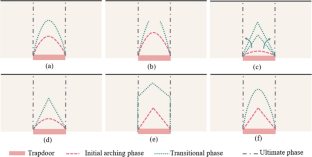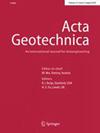A comprehensive analysis of the evolutionary dynamics of soil arches is crucial for accurately predicting soil deformations above sinkholes and assessing stability of underground structures. In this study, a series of trapdoor tests were conducted to investigate the progressive development of soil arching in dense sand. The particle image velocimetry (PIV) technique was utilized to capture soil deformation patterns, while fiber optic strain sensing cables were used to validate the displacement influence zone of soil by measuring strain profiles of the foundation. The ground reaction curves, derived from the measurements of earth pressure cells, shed light on the evolution process of stress redistribution and the rotation of principal stresses. The test results reveal that the formation of soil arching alters the overlying pressure on the trapdoor, transferring loads from yielding soil to adjacent stationary soil. The development of soil failure surfaces corresponded with vertical stress variations on the trapdoor. The strain profiles exhibited a characteristic trough above the trapdoor, along with double peaks at its edges. The measurements of micro-anchored strain sensing cables with small anchor spacings provided more accurate distributions of soil shear deformation. Furthermore, the orientation and magnitude of soil arching was inferred from principal stress rotations. The insights gained in this study are valuable for understanding the propagation of soil arching, offering potential implications for the execution of rational geotechnical design and the mitigation of related geological hazards.



